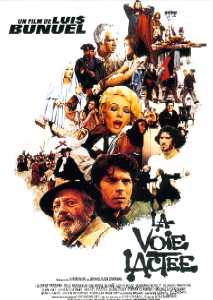The Milky Way (1969 film)
| The Milky Way | |
|---|---|

The French theatrical poster.
|
|
| Directed by | Luis Buñuel |
| Produced by | Serge Silberman |
| Starring |
Paul Frankeur Laurent Terzieff Michel Piccoli |
| Cinematography | Christian Matras |
|
Running time
|
91 min (France) 101 min (Germany) 105 min (USA) |
| Country | France West Germany Italy |
| Language | French |
The Milky Way (French: La Voie lactée) is a 1969 surrealist film directed by Luis Buñuel. It stars Laurent Terzieff, Paul Frankeur, Delphine Seyrig, Georges Marchal and Michel Piccoli. Buñuel later called The Milky Way the first in a trilogy (along with The Discreet Charm of the Bourgeoisie and The Phantom of Liberty) about “the search for truth."
The title of the film is taken from a popular name used for the Way of St. James, a route often traveled by religious pilgrims that stretched from northern Europe to the Santiago de Compostela in Spain, where the Remains of St. James were reputed to be buried. The film follows the picaresque journey of two vagabond travelers, who take the pilgrimage, not necessarily for religious reasons, but more as a means of escape, and along the way, witness a series of bizarre incidents involving the perpetrators of documented heresies in church history, and at key moments encounter Jesus and the Virgin Mary, as well as modern believers and fanatics. The plot is non-linear and functions as a highly symbolic travelogue across time and space, set over the last two thousand years, encompassing much of Christian history that, while using satire to critique religion from a skeptical perspective, also attempts to extract verities out of the act of spiritual quest and search for meaning.
The highly idiosyncratic film originally met with limited success but is today very well-regarded amongst film enthusiasts and critics.
In the film, two men travel the ancient pilgrimage road to Santiago de Compostela and meet embodiments of various Catholic heresies along the way. These religious events are based on actual historical documents. For instance, the archbishop whose corpse is exhumed and publicly burned is based on Archbishop Carranza of Toledo. The film ends with the following text:
...
Wikipedia
